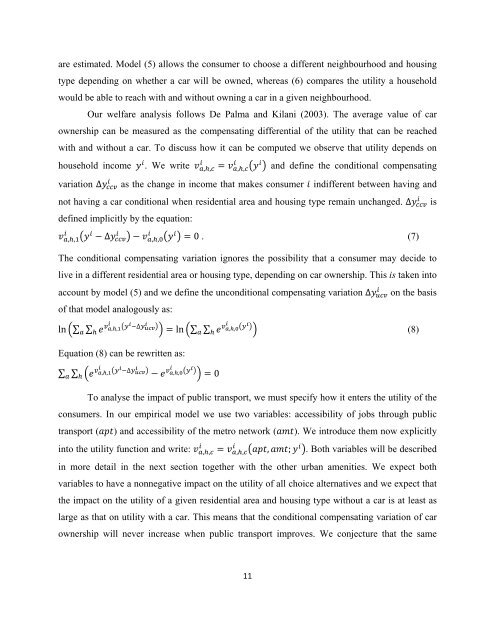Car Ownership? Evidence from the Copenhagen Metropolitan Area
n?u=RePEc:tin:wpaper:20150139&r=dem
n?u=RePEc:tin:wpaper:20150139&r=dem
Create successful ePaper yourself
Turn your PDF publications into a flip-book with our unique Google optimized e-Paper software.
are estimated. Model (5) allows <strong>the</strong> consumer to choose a different neighbourhood and housing<br />
type depending on whe<strong>the</strong>r a car will be owned, whereas (6) compares <strong>the</strong> utility a household<br />
would be able to reach with and without owning a car in a given neighbourhood.<br />
Our welfare analysis follows De Palma and Kilani (2003). The average value of car<br />
ownership can be measured as <strong>the</strong> compensating differential of <strong>the</strong> utility that can be reached<br />
with and without a car. To discuss how it can be computed we observe that utility depends on<br />
household income <br />
. We write ,, ,, and define <strong>the</strong> conditional compensating<br />
<br />
variation ∆ as <strong>the</strong> change in income that makes consumer indifferent between having and<br />
<br />
not having a car conditional when residential area and housing type remain unchanged. ∆ is<br />
defined implicitly by <strong>the</strong> equation:<br />
<br />
,,<br />
<br />
∆ <br />
<br />
,, 0 . (7)<br />
The conditional compensating variation ignores <strong>the</strong> possibility that a consumer may decide to<br />
live in a different residential area or housing type, depending on car ownership. This is taken into<br />
<br />
account by model (5) and we define <strong>the</strong> unconditional compensating variation ∆ on <strong>the</strong> basis<br />
of that model analogously as:<br />
ln ∑ ∑ <br />
,,<br />
<br />
<br />
∆<br />
<br />
Equation (8) can be rewritten as:<br />
∑ ∑ <br />
,,<br />
<br />
<br />
∆<br />
<br />
<br />
<br />
ln∑ ∑ ,,<br />
(8)<br />
<br />
,,<br />
<br />
0<br />
To analyse <strong>the</strong> impact of public transport, we must specify how it enters <strong>the</strong> utility of <strong>the</strong><br />
consumers. In our empirical model we use two variables: accessibility of jobs through public<br />
transport () and accessibility of <strong>the</strong> metro network (). We introduce <strong>the</strong>m now explicitly<br />
<br />
into <strong>the</strong> utility function and write: ,, ,, , ; . Both variables will be described<br />
in more detail in <strong>the</strong> next section toge<strong>the</strong>r with <strong>the</strong> o<strong>the</strong>r urban amenities. We expect both<br />
variables to have a nonnegative impact on <strong>the</strong> utility of all choice alternatives and we expect that<br />
<strong>the</strong> impact on <strong>the</strong> utility of a given residential area and housing type without a car is at least as<br />
large as that on utility with a car. This means that <strong>the</strong> conditional compensating variation of car<br />
ownership will never increase when public transport improves. We conjecture that <strong>the</strong> same<br />
11


